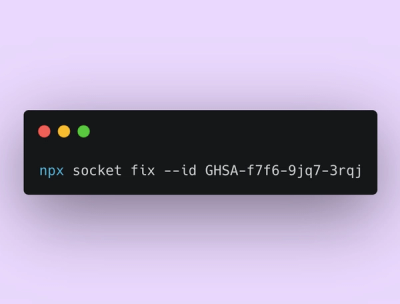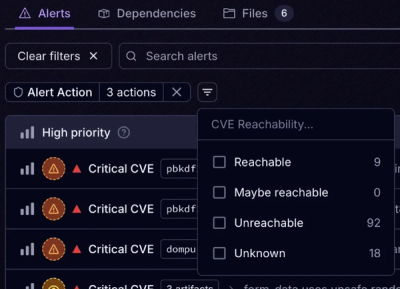
Product
Announcing Socket Fix 2.0
Socket Fix 2.0 brings targeted CVE remediation, smarter upgrade planning, and broader ecosystem support to help developers get to zero alerts.
@line/liff-cli
Advanced tools
$ npm i @line/liff-cli@latest
The channel command is used to manage LIFF channels. You can add or set the current channel with the following subcommands:
To add a channel, use the add subcommand with the channel ID and channel secret. You will be prompted to enter the channel secret.
$ liff-cli channel add [channelId]
To set the current channel, use the use subcommand with the channel ID.
$ liff-cli channel use [channelId]
The app command is used to manage LIFF apps. You can create, list, or delete LIFF apps with the following subcommands:
To create a new LIFF app, use the create subcommand with the required options: channel ID (optional), name, endpoint URL, and view type.
$ liff-cli app create \
--channel-id [channelId] \
--name <name> \
--endpoint-url <endpointUrl> \
--view-type <viewType>
To update an existing LIFF app, use the update subcommand with the LIFF app ID and the desired options to update. You can update the name, endpoint URL, and view type of the app.
$ liff-cli app update \
--liff-id <liffId> \
--channel-id [channelId] \
--name [newName] \
--endpoint-url [endpointUrl] \
--view-type [viewType]
To list all LIFF apps, use the list subcommand. You can optionally specify a channel ID to list apps for a specific channel.
$ liff-cli app list \
--channel-id [channelId]
To delete a LIFF app, use the delete subcommand with the LIFF app ID.
$ liff-cli app delete \
--liff-id <liffId> \
--channel-id [channelId]
The init command sets up a development environment for LIFF apps using the LIFF CLI.
This command creates a new LIFF app and uses @line/create-liff-app to generate the LIFF app template.
$ liff-cli init \
--channel-id [channelId] \
--name <name> \
--endpoint-url <endpointUrl> \
--view-type <viewType>
The scaffold command is used to create a new LIFF app template using the @line/create-liff-app utility.
$ liff-cli scaffold <app-name> [options]
Options:
-l, --liff-id [liffId] - Optional LIFF ID to use with the app templateExample:
$ liff-cli scaffold my-liff-app
$ liff-cli scaffold my-liff-app --liff-id 1234567-abcdef
The serve command is used to start local dev server with HTTPS and update an endpoint URL.
local-proxyBefore using the serve command, you need to create localhost.pem and localhost-key.pem in the root directory using mkcert. Follow these steps:
mkcert if you haven't already:$ brew install mkcert
$ mkcert -install
$ mkcert localhost
localhost.pem and localhost-key.pem files in the root directory of your project.ngrok-v1[!WARNING] This feature is deprecated.
Before using the serve command, you need to install ngrok and node-pty.
Before proceeding, ensure that your LIFF app is running locally. The url (or host and port) used in the following commands should correspond to your locally running LIFF app.
To start the server, use one of the following commands:
$ liff-cli serve \
--liff-id <liffId> \
--url <url> \
--proxy-type <local-proxy | ngrok-v1> \
--inspect \
--ngrok-command <ngrokCommand>
or
$ liff-cli serve \
--liff-id <liffId> \
--host <host> \
--port <port> \
--proxy-type <local-proxy | ngrok-v1> \
--inspect \
--ngrok-command <ngrokCommand>
$ npm run build
$ npm run test
$ node --run release
$ git push --follow-tags
Please follow the contributing guidelines to contribute to the project.
LIFF CLI is under Apache License, Version 2.0
FAQs
## Getting Started
The npm package @line/liff-cli receives a total of 103 weekly downloads. As such, @line/liff-cli popularity was classified as not popular.
We found that @line/liff-cli demonstrated a healthy version release cadence and project activity because the last version was released less than a year ago. It has 4 open source maintainers collaborating on the project.
Did you know?

Socket for GitHub automatically highlights issues in each pull request and monitors the health of all your open source dependencies. Discover the contents of your packages and block harmful activity before you install or update your dependencies.

Product
Socket Fix 2.0 brings targeted CVE remediation, smarter upgrade planning, and broader ecosystem support to help developers get to zero alerts.

Security News
Socket CEO Feross Aboukhadijeh joins Risky Business Weekly to unpack recent npm phishing attacks, their limited impact, and the risks if attackers get smarter.

Product
Socket’s new Tier 1 Reachability filters out up to 80% of irrelevant CVEs, so security teams can focus on the vulnerabilities that matter.